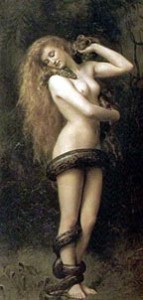The story of Lilith appears in a variety of cultures throughout history, mostly as a vampire or demon of some form. The earliest mention of Lilith is in a Sumerian epic poem, dated to about 2000 B.C., though most of our knowledge of Lilith comes primarily from Jewish mythology. Though the stories and interpretations vary, Lilith is generally considered to have been created from the earth, as Adam was. Like Eve after her, Lilith was created so that Adam had a partner in life, but they fought all the time. Ultimately, Lilith deserted Adam because, according to the Alphabet of Ben Sirach (a medieval text), they fought about who would be in the dominant sexual position. Adam wished to always be on top, and Lilith argued that as she was created in the same way Adam was, they were equal. Unable to resolve their differences (Adam tried to force her obedience), she uttered the unspeakable name of God and fled to the Red Sea, where she cavorted with demons. Adam prayed for her return, and though God sent three angels to bring her back to Adam, she refused, and they were unable to force her to return. However, she told the angels that she knew she was created to cause sickness and death in children, and so she struck a bargain with the angels (and God). She could inflict harm upon infant boys for up to 8 days, or girls for up to 20 days. However, she would not be able to harm infants protected by an amulet with the names or images of the three angels upon it, and would instead have to harm her own offspring (she gave birth to 100 lilin–demons–every day, from laying with the demons in the Red Sea). But Adam was still lonely without a partner, so God placed him into a deep sleep, and formed Eve from one of his ribs. When Adam awoke, he recognized Eve as being a part of him, and accepted her as his partner, and she him.
My first encounter with Lilith was in a reference in The Lion, the Witch and the Wardrobe, by C.S. Lewis, where she is mentioned as being an ancestor of the White Witch (the antagonist). Lilith is also referred to as a mother of demons, and Lewis used that reference to imply that the White Witch Jadis was more than just an witch (which also serves to further Aslan’s image as Christ). I didn’t know these things as a child first reading C.S. Lewis, but as I began university so did the concert tour Lilith Fair, and so I learned who Lilith was (greatly coloring any future readings of The Chronicles of Narnia; as a child I was blissfully unaware of the religious overtones). And as an impressionable 19 year old, I learned about her from the only people interested in her: feminists.
As a spiritual character, Lilith is unrepentant and evil: she’s a villain in the Judeo-Christian creation story. No reasons for her actions are given, and they aren’t necessarily needed. Through proper actions and behavior, Lilith and her succubus offspring can be thwarted, and Adam found a partner who made him happy. But for those of us unsatisfied with leaving it there, feminist theory makes things more clear.
Lilith wished to be treated as an equal, including in the bedroom (so to speak). She wasn’t subservient to Adam, and Adam wasn’t happy about that (though he also wasn’t happy when she left). Questionable though it may be, she found a place and a role which suited her, but historically, female independence and sexual proclivity have been demonized–quite literally, in her case. A woman’s place was with her husband, and her role was to be submissive to him and a nurturing mother to their children. Lilith was neither of these things, which makes her inexplicable to men, and a heroine to feminists, because Lilith was the first woman to disrupt the male status quo.
For more on Lilith and interpretations of her role in mythology, read chapter 7 of Christopher L.C.E. Witcombe’s paper, “Eve and the Identity of Women.”
-Katie Weidmann
Junior Girl
Girl Museum Inc.

